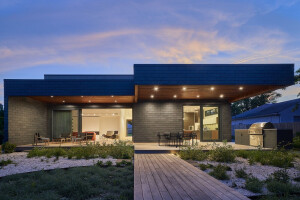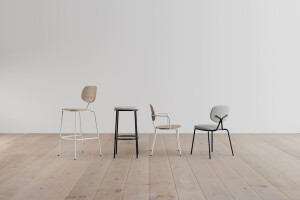A flowing, ribbon-like wall has been installed in the new Istanbul Airport that unites a suite of lounges, forming an intuitive route through space that transcends barriers of language and culture. Designed by Softroom for Turkish Airlines, the Flow Wall is over akilometre long, making it one of the longest parametric interior forms in the world. It provides the visual signature that weaves through the six new lounges, creating a series of unified areas that cater for the differing needs of passengers.
The wall and the 19,000 sqm of lounges that it knits together are the result of an international competition won by Softroomto create physical spaces thatembody Turkish Airline’s new brand philosophy of ‘flow’ within the airport environment. But beyond symbolic value, the Flow Wall directly forms a seamless passenger journey, by acting as an organising feature through a series of lounges. The wall shifts and changes as it moves through the lounges to accentuate various functions. When it reaches the cinema room, it shrinks down to draw passengers towards the screen, while at the main kitchen area it raises up into a peak to act as a beacon from afar.
Placed high-up on the central axis of the building, and resonating with the domed forms of the main roof, the Flow Wallis immediately identifiable from the entrance, highlighting the prime location of the Turkish Airlines’ lounges as a centrepiece of the terminal. The ribbon starts its role as a guide through Turkish Airlines’ premium check-in zone. At the main entrances to the lounges, the iconic Turkish Airlines logo punctuates the installation, which then leads passengers up to a calm refuge at the centre of a busy airport. The wall flows through the reception area and then into the main space, which becomes a hub for access to many different zones. Inspired by Istanbul, this light-filled and uplifting interior space feels more like an open-air courtyard, where passengers feel revived, invigorated and refreshed.
Passengers will move effortlessly through zones and the form of the Flow Wallwill relate this experience to the lightness and dynamism of air travel. Contemporary and dynamic, the wall also has a natural quality that has been imbued into the surface of the wall, which provides a warmth and character to the spaces that it encloses. To achieve this, the complex forms were realised in a plywood structure, skinned in strips of bleached oak.The surface is divided by seven flowing lines, representing how Turkish Airlines connect the continents of the world.Light is also used to increase intuitive wayfinding. Flow lines in the wall itself are animated by over five-and-a-half kilometres of programmable LED lightingthat can pulse or glow when needed, and overhead strips of lighting at the lower levels follow the contours of particular routes, reflecting off the highly polished floor.
Softroom director Christopher Bagot said: “Turkish Airlines needed us to deliver an iconicdesign for their loungesthat symbolizes their seamless passenger experience and envelops passengers in an atmosphere of Turkish hospitality. The Flow Wall is a groundbreaking project that transcends languages and which shows how creativity and technology can combine to reconsider the ways we delineate interior space and guide passengers through intuitive wayfinding.”
The six lounges are made up of two6,000 sqminternational departure lounges (one for business class and one for loyalty programme passengers); a 2,700 sqmExclusive lounge for Turkish Airlines’ most frequent flyers;a lounge for arriving passengers and two domestic lounges with their own check-in and departure areas that have become a mini terminal in their own right.
Continuing their successful partnership with Turkish Airlines, the lounges are operated and catered by Turkish Do&Co. The focus of the main spaces is food and hospitality and there is a choice of over seven different live cooking counters for passengers to select from, including the famed Pide experience. Turkish Airlines and Do&Cofurnished the lounges and invited local designers to create an installation of an Aegean taverna in the main courtyard, accentuating Turkish food heritage, and a tea room and library behind the ribbon, highlighting the local popularity and variety of this drink.
Sleeping suites and shower rooms provide much-needed private space, featuring a custom-designed dressing area and desk, as well as a generous bed. With full-height glazing overlooking the apron, hardwood floors and Alcantara wall cladding, these suites are the most luxurious spaces available in any airport for a business class passenger. Other functions, like daybed rest areas, cinema, news room, gaming zone, children’s play area and library occupy spaces off to each side of the central courtyard, architecturally defined by the Flow Wall. Prayer rooms, work pods and lockers are located just by the entrance. In the areas beneath the main lounges, mirrored ceilings are used to create an illusionary effect that replicates the open-air courtyard sensation above.
The international Business Lounge is unique as it also contains a museum space, lined with display cases which will house a changing exhibition of contemporary and historic Turkish art and artefacts. The opening display will feature contemporary artworks from partner Istanbul Modern's own collection.









































